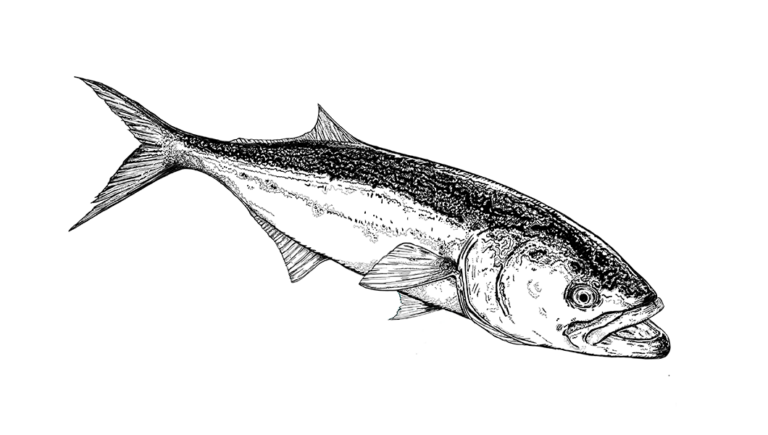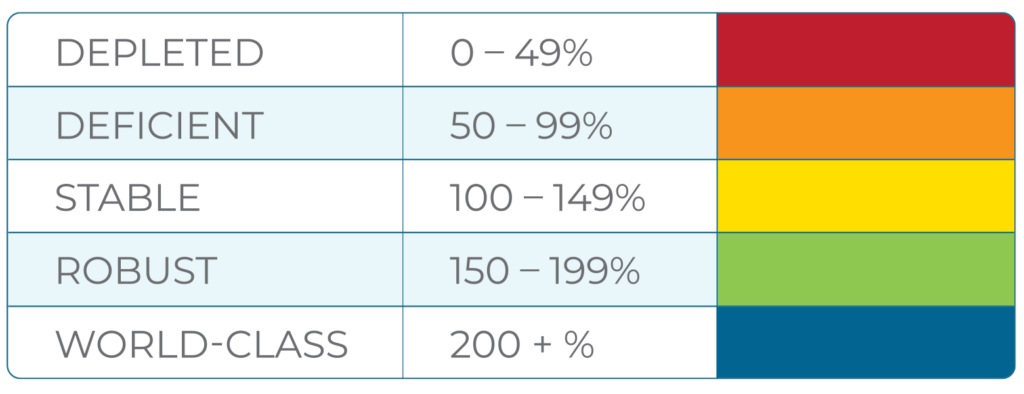Bluefish


94.16% = DEFICIENT
How It’s Calculated
FINDEX is a novel way to gauge whether the status of a fish population is trending up or down. Management of most fish species in North Carolina is guided by stock assessment models developed by various groups of scientists. The calculations in our FINDEX metric measure the gap between the desired condition of a fish stock (the Target reference value) and the existing condition (the most recent data year in the model called the Terminal value) as determined in each stock assessment. The gaps between Target and Terminal values are reported as ratios.
For example, if the Target and Terminal values are the same, there would be no gap, and the ratio would be 1.0. The multiplier on our FINDEX barometer would set the FINDEX value at 100% in this example and assign a stock status designation of “Stable.” Categories on the FINDEX barometer are measurable as they track the extent of the gap either above or below the “Stable” designation.
For Bluefish, the FINDEX gap assessment compared Target and Terminal values of Fishing Mortality (F35%) and Spawning Stock Biomass (SSB35%) from the 2022 stock assessment support information. The model, which includes Bluefish data from North Carolina, was developed jointly by the Atlantic States Marine Fisheries Commission and the Mid-Atlantic Fishery Management Council. The Terminal year in the stock assessment model was 2022.
Here's the FINDEX formula used for Bluefish:

- (1.572 x 0.599) x 100 = 94.16%
- FINDEX = 94.16% for 2022
- 94.16% = DEFICIENT

What Does Deficient Mean?
“Deficient” is assigned to any stock with a FINDEX value between 50 and 99%. The most recent peer-reviewed stock assessment model for Bluefish (2022 data) tells a mixed story.
Fishing mortality performed well relative to the target reference point, indicating overfishing was not occurring. On the other hand, Spawning Stock Biomass remained well below the target, indicating the stock was overfished. Stock status suggesting “overfishing” is not occurring, while at the same time indicating that the stock is “overfished” is difficult to interpret. Our FINDEX metric remedies this confusion by classifying the Bluefish stock as “Deficient.”
FINDEX Stock Status Over Time
The stock assessment model for Bluefish provides point estimates of Fishing Mortality and Spawning Stock Biomass for each year covered in the data set. We’ve compared the Target reference values to these annual point estimates and calculated the ratios (gaps) for each data year from 1985–2022.
Applying the FINDEX gap assessment to the entire time series provides the following stock status trendline:
No Data Found
How Do We Get To World-Class?
FINDEX can also be used to determine when a population has reached “World-Class” status. Because FINDEX factors performance of both Fishing Mortality and Spawning Stock Biomass into the metric, multiple combinations of these values could potentially lead to a World-Class designation.
Bluefish Target values for Fishing Mortality (0.239) and Spawning Stock Biomass (88,131 metric tons) have been established by the management agencies. The existing estimates (2022 values) are 0.152 and 52,747 metric tons. Under one potential scenario, if Fishing Mortality remained at the 2022 estimate and Spawning Stock Biomass was to increase to 112,500 metric tons, then the FINDEX value would exceed 200% on our barometer. The vision of the NC Marine & Estuary Foundation is to see our coastal stocks exceed Target expectations as we pursue World-Class fisheries and thriving coastal economies.
Commercial Trends
The graph below illustrates commercial trends for Bluefish from 1990 through 2022. In 2022, commercial fishers harvested 872,041 pounds of Bluefish valued at $513,425. Supporting data was sourced from the North Carolina Department of Environmental Quality.
No Data Found
Recreational Trends
The graph below illustrates recreational trends for Bluefish from 1990 through 2022. In 2022, recreational fishers harvested an estimated 1,533,911 Bluefish weighing 1,645,410 pounds. Supporting data was collected through the Marine Recreational Information Program as sourced from the North Carolina Department of Environmental Quality.
No Data Found
State Record
- North Carolina’s state record Bluefish was landed off Cape Hatteras on January 30, 1972, by James Hussey.
- The record-breaking fish, which is also the All-Tackle World Record, weighed 31 pounds, 12 ounces.
Did you know?
- The scope of North Carolina’s authority to manage Bluefish is limited to actions that are consistent with federal fishery management plans developed by the Mid-Atlantic Fishery Management Council and the Atlantic States Marine Fisheries Commission.
- Bluefish migrate in the open waters of the Atlantic Ocean from Maine to Florida and are commonly found in North Carolina’s estuaries from March through October.
- Known to be voracious feeders, large schools of Bluefish can be seen shredding baitfish during what’s commonly called a Bluefish “blitz”.
- Spawning occurs offshore from Massachusetts to Florida.
Harvest Seasons for Bluefish
- The recreational limit for Bluefish is currently 3 fish per day, except persons fishing on a for-hire vessel can keep 5 fish per day. There is no size limit.
- Commercial Bluefish landings are managed through an annual quota which was set at 1,056,058 pounds in 2020. Daily trip limits are commonly required. Proclamations for Bluefish can be found here.
What’s Next?
As our team diligently refines FINDEX, we are committed to delivering the most recent stock status updates for North Carolina’s diverse finfish species. Subscribe below to receive a stream of inshore insights and stay current with our coastal initiatives.
Stay Current
Sign up for our exclusive fisheries updates.

